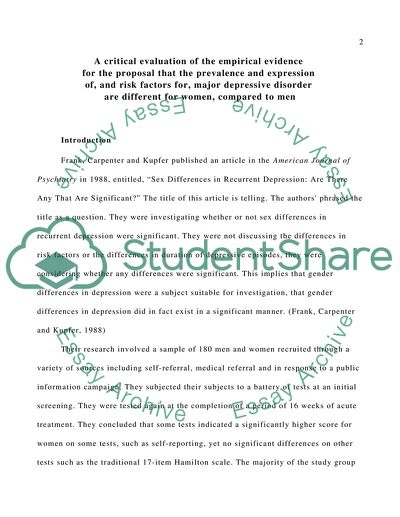Cite this document
(Empirical Evidence For The Proposal That the Prevalence and Expression Literature review, n.d.)
Empirical Evidence For The Proposal That the Prevalence and Expression Literature review. Retrieved from https://studentshare.org/health-sciences-medicine/1744583-critically-evaluate-the-empirical-evidence-for-the-proposal-that-the-prevalence-and-expression-of-and-risk-factors-for-major-depressive-disorder-are-different-for-women-compared-to-men
Empirical Evidence For The Proposal That the Prevalence and Expression Literature review. Retrieved from https://studentshare.org/health-sciences-medicine/1744583-critically-evaluate-the-empirical-evidence-for-the-proposal-that-the-prevalence-and-expression-of-and-risk-factors-for-major-depressive-disorder-are-different-for-women-compared-to-men
(Empirical Evidence For The Proposal That the Prevalence and Expression Literature Review)
Empirical Evidence For The Proposal That the Prevalence and Expression Literature Review. https://studentshare.org/health-sciences-medicine/1744583-critically-evaluate-the-empirical-evidence-for-the-proposal-that-the-prevalence-and-expression-of-and-risk-factors-for-major-depressive-disorder-are-different-for-women-compared-to-men.
Empirical Evidence For The Proposal That the Prevalence and Expression Literature Review. https://studentshare.org/health-sciences-medicine/1744583-critically-evaluate-the-empirical-evidence-for-the-proposal-that-the-prevalence-and-expression-of-and-risk-factors-for-major-depressive-disorder-are-different-for-women-compared-to-men.
“Empirical Evidence For The Proposal That the Prevalence and Expression Literature Review”, n.d. https://studentshare.org/health-sciences-medicine/1744583-critically-evaluate-the-empirical-evidence-for-the-proposal-that-the-prevalence-and-expression-of-and-risk-factors-for-major-depressive-disorder-are-different-for-women-compared-to-men.


